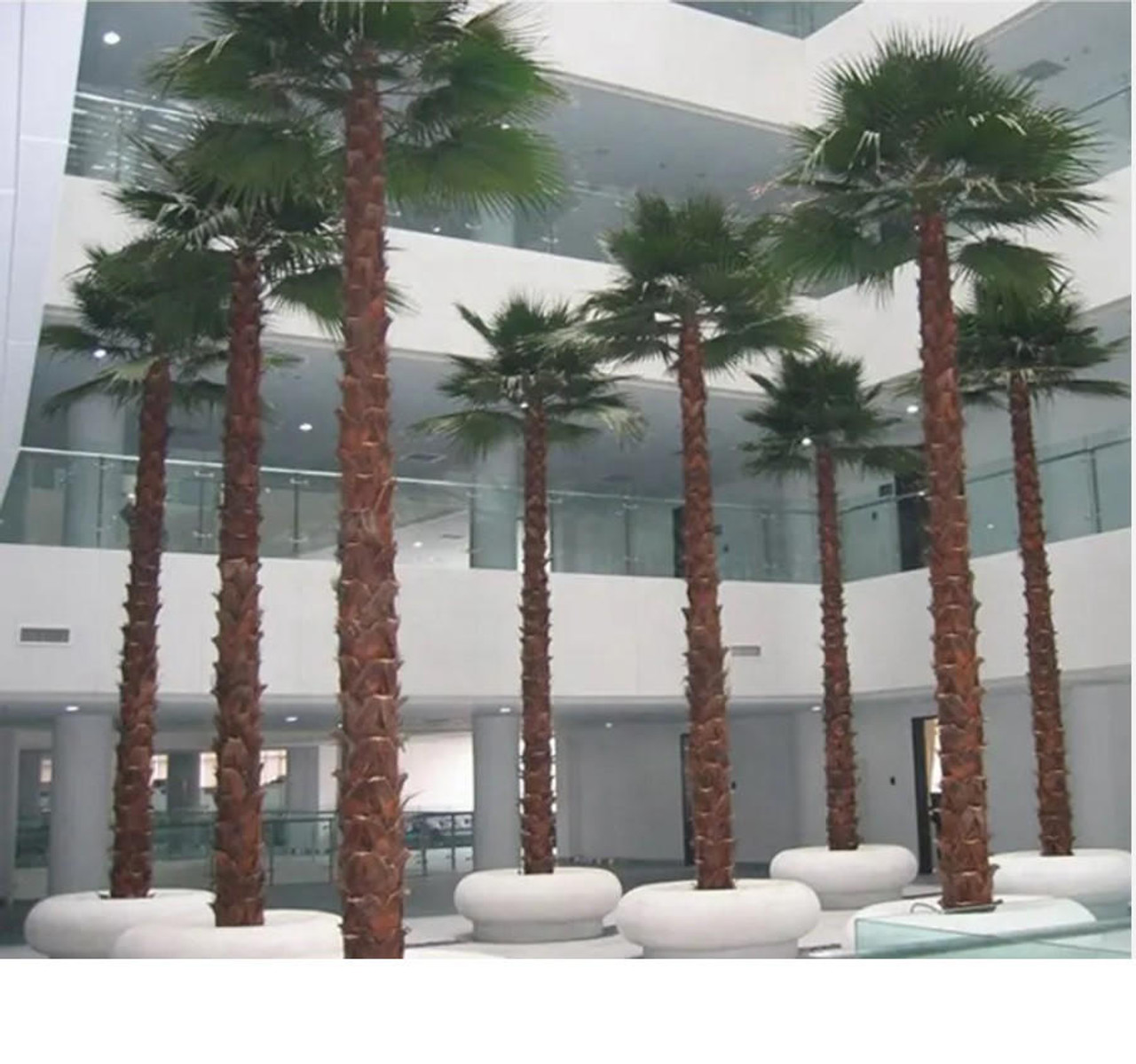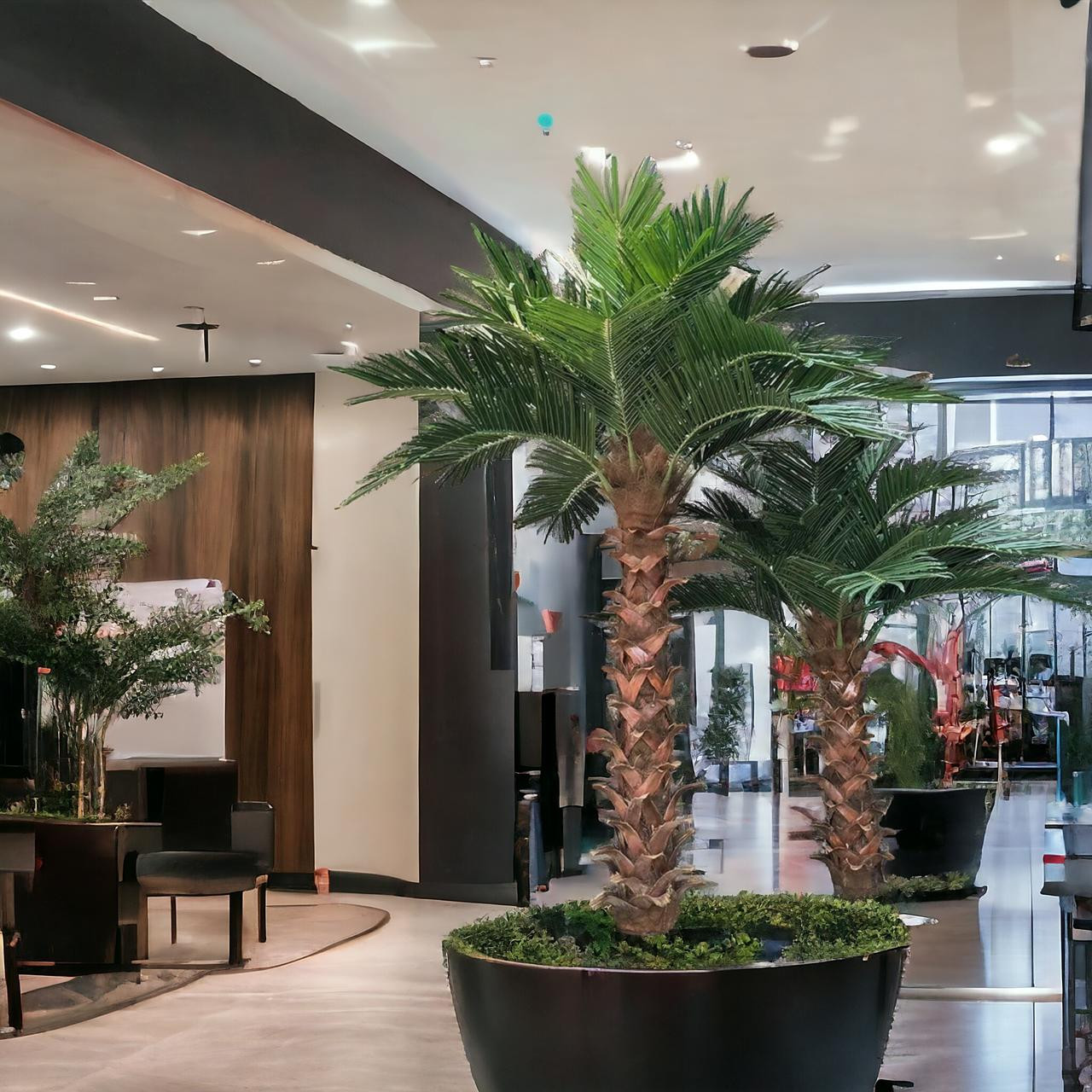Top Benefits of Artificial Palm Trees for Outdoor Use in Modern Landscaping
Posted by Jessie Meldrew - Fashion Blogger on 8th Oct 2024
Introduction
The art of landscaping is constantly evolving, melding practicality with the aesthetic aspirations of modern society. Today, we explore the unexpected yet exciting realm of artificial botanical wonders, with a particular focus on artificial palm trees for outdoor use. These remarkable creations have seamlessly woven themselves into our urban and suburban spaces, providing an alternative to traditional greenery that challenges preconceived notions of authenticity and beauty. But why have they become so integral to our modern landscapes, and what benefits do they confer upon the spaces we inhabit? This discourse aims to unravel the virtues of using artificial palm trees in outdoor settings, illuminating their role in contemporary design and development.
The Aesthetic Appeal of Artificial Palm Trees
The primary allure of artificial palm trees for outdoor use is undeniably their aesthetic brilliance, a perfect symbol of the fusion between nature and artifice. Urban planners and landscapers often seek to kindle a sense of paradise—a paradise that palm trees inherently invoke. Artificial palms achieve this effortlessly, rendering landscapes that are simultaneously exotic and inviting.
Whether lining a bustling boulevard or gracing the exterior of a sophisticated resort, these faux trees exhibit lifelike semblance with striking realism. Through advanced manufacturing techniques, each tree mimics the textural nuances and rich hues of nature’s creations without succumbing to the frailties of organic life—the withering in drought, the brittleness in frost. By presenting people with a perpetual vista of verdant pleasure, artificial palm trees afford a transformative experience of space that feels perennially lush and vibrant.
Furthermore, the aesthetic value of artificial palms extends beyond mere visual appeal. They inherently possess a versatility that allows them to seamlessly integrate into diverse environmental settings, from urban plazas to serene gardens. This adaptability through design innovation makes them an integral feature in crafting visually arresting and thematic outdoor spaces. The visual continuity provided by artificial palm trees also allows for a seamless blending of natural and human-made environments, enhancing the overall aesthetic experience for those who encounter these landscapes.
Year-Round Durability and Practicality
One of the quintessential benefits of deploying artificial palm trees for outdoor use is their resilience. Unlike their real counterparts, artificial palms do not suffer from seasonal adversities or the relentless onslaught of pests. This durability translates into contexts where consistent appearance is pivotal; envision the manicured gardens of corporate campuses or the immaculately designed rooftop terraces of urban apartment complexes.
Artificial palms withstand wind, rain, snow, and sun alike, maintaining their integrity and appearance without the need for rigorous repair or replacement. This resilience ensures that landscape architects have at their disposal a reliable element that sustains its aesthetics without interruption. Such permanence is invaluable in settings where continuity and low maintenance are paramount.
Moreover, in regions where extreme weather conditions are commonplace, the steadfast nature of artificial palm trees becomes an invaluable asset. For instance, in coastal cities prone to tropical storms or in areas subjected to heavy snowfall, the durability of these trees ensures that landscapes retain their pristine condition regardless of natural adversities. This aspect not only augments the practicality of adopting artificial palms in diverse climates but also underscores their ability to provide a consistent and unwavering landscape feature.
Environmental and Economic Efficiency
An often undersold aspect of artificial palm trees for outdoor use is their environmental and economic sensibility. As the global community increasingly races towards sustainability, artificial plants offer a unique solution. Unlike live plants, faux palms do not require water, pesticides, or fertilizers, therefore conserving natural resources and minimizing ecological footprint.
This sustainable approach further extends to economic considerations. The initial investment into artificial palms is balanced by the elimination of long-term costs associated with horticultural care. With no need for ongoing pruning, watering, or soil conditioning, they present a one-time financial outlay with minimal subsequent expenditures, proving cost-effective over their extended lifespan.
- Eliminate ongoing maintenance costs
- Reduce water usage and dependency
- Eliminate the use of harmful pesticides and chemicals
In an era where water conservation is an imperative societal goal, the use of artificial palm trees represents an environmentally responsible choice. By opting for these synthetic counterparts, landscapes can remain verdant without placing additional stress on increasingly scarce water resources. Additionally, the absence of chemical treatments means that artificial palms actively contribute to a reduction in environmental pollution, aligning with broader ecological goals and initiatives.
Versatility and Customization
Artificial palm trees are supremely versatile, with a range of shapes, sizes, and species replicas available. This versatility adds immense value in urban design, where space and individuality are at a premium. Artificial palms empower designers to customize vegetation layouts that fit precisely within their unique vision, regardless of the inherent limitations of organic growth.
These trees can be fashioned to accommodate diverse thematic environments, from tropical oases in urban centers to minimalistic desertscapes in arid locales. They offer endless possibilities for innovative arrangements, acting as central pieces or complementary elements within broader landscape schemes. This flexibility allows planners to deploy them in both expansive estates and confined courtyards, ensuring suitability across a multitude of environmental contexts.
Furthermore, the incorporation of artificial palm trees facilitates the creation of cohesive and themed outdoor spaces that resonate with cultural or historical motifs. Whether aiming to recreate the lush surroundings of an ancient civilization or to introduce a modern sculptural element into an urban park, artificial palms provide the adaptability required to achieve such visionary landscapes.
Safety and Accessibility
The incorporation of artificial palm trees for outdoor use mitigates several safety concerns associated with natural flora. In public and commercial spaces, artificial greenery ensures that fallen leaves or branches do not pose hazards, maintaining a clean and safe environment. Their predictability and control in growing dimensions assure compliance with various zoning and architectural codes, eliminating unforeseen breaches or liabilities.
Moreover, faux palms are often more accessible for those with allergies—a consideration of increasing relevance as public spaces strive to be inclusive and adaptable to varying needs. By adopting artificial solutions, designers can craft verdant locales that are exoteric and egalitarian, deferring the limitations of organic plant interaction.
In settings where public safety and inclusivity are of paramount importance, the controlled nature of artificial palm trees becomes a strategic advantage. These installations predictably conform to design specifications, ensuring that landscape elements do not inadvertently impede accessibility or pose risks. Consequently, artificial palms serve as a means to achieve harmonious equilibrium between aesthetic appeal and functional space utilization.
A Constant in a Changing World
Artificial palm trees for outdoor use stand as reliable constants amidst the tumultuous changes of our modern environment. They represent consistency—both in visual appeal and existential presence—in a world where the natural and built landscapes are invariably in flux. As the very climate itself alters, these trees hold fast in their ordained beauty, offering predictability in cultural milieus that yearn for constancy.
Within the storied framework of our urban experiences, they weave narratives of continuity. Not only do they provide the sensory pleasures of shade and structure, but they also engender the emotional resonance of time-honored spaces. In their synthesis lies contentment, a steadfast expectation amid the unpredictable dynamism of urban evolution.
Amidst the constant evolution of urban design and land development, the stable presence of artificial palm trees offers a comforting visual anchor. As urban landscapes are continually reimagined and reshaped, the enduring allure of artificial palms ensures that they remain a constant element, bridging the gap between tradition and innovation.
Conclusion
In summation, artificial palm trees for outdoor use encapsulate the aspirations of modern landscaping, merging form with function to substantiate spaces with enduring charm and practical benefit. Their aesthetic allure, perennial resilience, and environmental pragmatism position them as indispensable tools in the architect's arsenal. Emancipated from the constraints of nature, they invite innovation and creativity where the traditional might falter. As we embrace the future of landscape artistry, artificial palms remind us that sometimes, the most profound expressions of nature begin with a stroke of the artificial.




